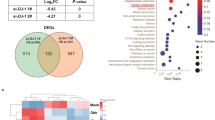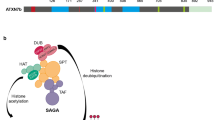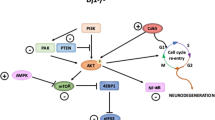Abstract
In the present study we demonstrated that neurotoxin MPP+-induced DNA damage is followed by ataxia telangiectasia muted (ATM) activation either in cerebellar granule cells (CGC) or in B65 cell line. In CGC, the selective ATM inhibitor KU-55933 showed neuroprotective effects against MPP+-induced neuronal cell loss and apoptosis, lending support to the key role of ATM in experimental models of Parkinson’s disease. Likewise, we showed that knockdown of ATM levels in neuroblastoma B65 cells using an ATM-specific siRNA attenuates the phosphorylation of retinoblastoma protein without affecting other cell-cycle proteins involved in the G0/G1 cell-cycle phase. Moreover, we demonstrated DNA damage, in human brain samples of PD patients. These findings support a model in which MPP+ leads to ATM activation with a subsequent DNA damage response and activation of pRb. Therefore, this study demonstrates a new link between DNA damage by MPP+ and cell-cycle re-entry through retinoblastoma protein phosphorylation.












Similar content being viewed by others
References
Gupta A, Dawson VL, Dawson TM (2008) What causes cell death in Parkinson’s disease? Ann Neurol 64(Suppl 2):S3–S15
González-Polo RA, Soler G, Alvarez A, Fabregat I, Fuentes JM (2003) Vitamin E blocks early events induced by 1-methyl-4-phenylpyridinium (MPP+) in cerebellar granule cells. J Neurochem 84:305–315
Smith PD, Crocker SJ, Jackson-Lewis V, Jordan-Sciutto KL, Hayley S, Mount MP, O’Hare MJ, Callaghan S, Slack RS, Przedborski S, Anisman H, Park DS (2003) Cyclin-dependent kinase 5 is a mediator of dopaminergic neuron loss in a mouse model of Parkinson’s disease. Proc Natl Acad Sci USA 100:13650–13655
Nair VD (2006) Activation of p53 signaling initiates apoptotic death in a cellular model of Parkinson’s disease. Apoptosis 11:955–966
Tretter L, Sipos I, Adam-Vizi V (2004) Initiation of neuronal damage by complex I deficiency and oxidative stress in Parkinson’s disease. Neurochem Res 29:569–577
González-Polo RA, Soler G, Fuentes JM (2004) MPP+ : mechanism for its toxicity in cerebellar granule cells. Mol Neurobiol 30:253–264
Leist M, Volbracht C, Fava E, Nicotera P (1998) 1-Methyl-4-phenylpyridinium induces autocrine excitotoxicity, protease activation, and neuronal apoptosis. Mol Pharmacol 54(5):789–801
Wang W, Ma C, Mao Z, Li M (2004) JNK inhibition as a potential strategy in treating Parkinson’s disease. Drug News Perspect 17:646–654
Chu CT, Zhu JH, Cao G, Signore A, Wang S, Chen J (2005) Apoptosis inducing factor mediates caspase-independent 1-methyl-4-phenylpyridinium toxicity in dopaminergic cells. J Neurochem 94:1685–1895
Smith PD, Mount MP, Shree R, Callaghan S, Slack RS, Anisman H, Vincent I, Wang X, Mao Z, Park DS (2006) Calpain-regulated p35/cdk5 plays a central role in dopaminergic neuron death through modulation of the transcription factor myocyte enhancer factor 2. J Neurosci 26:440–447
Nunomura A, Moreira PI, Lee HG, Zhu X, Castellani RJ, Smith MA, Perry G (2007) Neuronal death and survival under oxidative stress in Alzheimer and Parkinson diseases. CNS Neurol Disord Drug Targets 6:411–423
Nakaso K, Ito S, Nakashima K (2008) Caffeine activates the PI3 K/Akt pathway and prevents apoptotic cell death in a Parkinson’s disease model of SH-SY5Y cells. Neurosci Lett 432:146–150
Petit-Paitel A, Brau F, Cazareth J, Chabry J (2009) Involvement of cytosolic and mitochondrial GSK-3beta in mitochondrial dysfunction and neuronal cell death of MPTP/MPP-treated neurons. PLoS One 4:e5491
Pan J, Xiao Q, Sheng CY, Hong Z, Yang HQ, Wang G, Ding JQ, Chen SD (2009) Blockade of the translocation and activation of c-Jun N-terminal kinase 3 (JNK3) attenuates dopaminergic neuronal damage in mouse model of Parkinson’s disease. Neurochem Int 54:418–425
Smith PD, O’Hare MJ, Park DS (2004) CDKs: taking on a role as mediators of dopaminergic loss in Parkinson’s disease. Trends Mol Med 10:445–451
Höglinger GU, Breunig JJ, Depboylu C, Rouaux C, Michel PP, Alvarez-Fischer D, Boutillier AL, Degregori J, Oertel WH, Rakic P, Hirsch EC, Hunot S (2007) The pRb/E2F cell-cycle pathway mediates cell death in Parkinson’s disease. Proc Natl Acad Sci USA 104:3585–3590
Alvira D, Ferrer I, Gutierrez-Cuesta J, Garcia-Castro B, Pallàs M, Camins A (2008) Activation of the calpain/cdk5/p25 pathway in the girus cinguli in Parkinson’s disease. Parkinsonism Relat Disord 14:309–313
Alvira D, Tajes M, Verdaguer E, Acuña-Castroviejo D, Folch J, Camins A, Pallas M (2006) Inhibition of the cdk5/p25 fragment formation may explain the antiapoptotic effects of melatonin in an experimental model of Parkinson’s disease. J Pineal Res 40:251–258
Alvira D, Tajes M, Verdaguer E, de Arriba SG, Allgaier C, Matute C, Trullas R, Jiménez A, Pallàs M, Camins A (2007) Inhibition of cyclin-dependent kinases is neuroprotective in 1-methyl-4-phenylpyridinium-induced apoptosis in neurons. Neuroscience 146:350–365
Alvira D, Yeste-Velasco M, Folch J, Casadesús G, Smith MA, Pallàs M, Camins A (2007) Neuroprotective effects of caffeine against complex I inhibition-induced apoptosis are mediated by inhibition of the Atm/p53/E2F–1 path in cerebellar granule neurons. J Neurosci Res 85:3079–3088
McShea A, Harris PL, Webster KR, Wahl AF, Smith MA (1997) Abnormal expression of the cell cycle regulators P16 and CDK4 in Alzheimer’s disease. Am J Pathol 150:1933–1939
Raina AK, Zhu X, Rottkamp CA, Monteiro M, Takeda A, Smith MA (2000) Cyclin’ toward dementia: cell cycle abnormalities and abortive oncogenesis in Alzheimer disease. J Neurosci Res 61:128–133
Jordan-Sciutto KL, Dorsey R, Chalovich EM, Hammond RR, Achim CL (2003) Expression patterns of retinoblastoma protein in Parkinson disease. J Neuropathol Exp Neurol 62:68–74
Lim AC, Qi RZ (2003) Cyclin-dependent kinases in neural development and degeneration. J Alzheimers Dis 5:329–335
Krantic S, Mechawar N, Reix S, Quirion R (2005) Molecular basis of programmed cell death involved in neurodegeneration. Trends Neurosci 28:670–676
Nagy Z (2007) The dysregulation of the cell cycle and the diagnosis of Alzheimer’s disease. Biochim Biophys Acta 1772:402–408
Nagy Z (2005) The last neuronal division: a unifying hypothesis for the pathogenesis of Alzheimer’s disease. J Cell Mol Med 9:531–541
Becker EB, Bonni A (2004) Cell cycle regulation of neuronal apoptosis in development and disease. Prog Neurobiol 72:1–25
Pelegrí C, Duran-Vilaregut J, del Valle J, Crespo-Biel N, Ferrer I, Pallàs M, Camins A, Vilaplana J (2008) Cell cycle activation in striatal neurons from Huntington’s disease patients and rats treated with 3-nitropropionic acid. Int J Dev Neurosci 26:665–671
Copani A, Guccione S, Giurato L, Caraci F, Calafiore M, Sortino MA, Nicoletti F (2008) The cell cycle molecules behind neurodegeneration in Alzheimer’s disease: perspectives for drug development. Curr Med Chem 15:2420–2432
Iyirhiaro GO, Brust TB, Rashidian J, Galehdar Z, Osman A, Phillips M, Slack RS, Macvicar BA, Park DS (2008) Delayed combinatorial treatment with flavopiridol and minocycline provides longer term protection for neuronal soma but not dendrites following global ischemia. J Neurochem 105:703–713
Camins A, Verdaguer E, Folch J, Beas-Zarate C, Canudas AM, Pallàs M (2007) Inhibition of ataxia telangiectasia-p53–E2F-1 pathway in neurons as a target for the prevention of neuronal apoptosis. Curr Drug Metab 8:709–715
Chong ZZ, Li F, Maiese K (2006) Attempted cell cycle induction in post-mitotic neurons occurs in early and late apoptotic programs through Rb, E2F1, and caspase 3. Curr Neurovasc Res 3:25–39
Hamdane M, Bretteville A, Sambo AV, Schindowski K, Bégard S, Delacourte A, Bertrand P, Buée L (2005) p25/Cdk5-mediated retinoblastoma phosphorylation is an early event in neuronal cell death. J Cell Sci 118:1291–1298
Zhang Y, Qu D, Morris EJ, O’Hare MJ, Callaghan SM, Slack RS, Geller HM, Park DS (2006) The Chk1/Cdc25A pathway as activators of the cell cycle in neuronal death induced by camptothecin. J Neurosci 26:8819–8828
García-Alvarez G, Ventura V, Ros O, Aligué R, Gil J, Tauler A (2007) Glycogen synthase kinase-3beta binds to E2F1 and regulates its transcriptional activity. Biochim Biophys Acta 1773:375–382
Espada L, Udapudi B, Podlesniy P, Fabregat I, Espinet C, Tauler A (2007) Apoptotic action of E2F1 requires glycogen synthase kinase 3-beta activity in PC12 cells. J Neurochem 102:2020–2028
Macleod MR, Ramage L, McGregor A, Seckl JR (2003) Reduced NMDA-induced apoptosis in neurons lacking ataxia telangiectasia mutated protein. Neuroreport 14:215–217
Kruman II, Wersto RP, Cardozo-Pelaez F, Smilenov L, Chan SL, Chrest FJ, Emokpae R Jr, Gorospe M, Mattson MP (2004) Cell cycle activation linked to neuronal cell death initiated by DNA damage. Neuron 41:549–561
Schwartz EI, Smilenov LB, Price MA, Osredkar T, Baker RA, Ghosh S, Shi FD, Vollmer TL, Lencinas A, Stearns DM, Gorospe M, Kruman II (2007) Cell cycle activation in postmitotic neurons is essential for DNA repair. Cell Cycle 6:318–329
Verdaguer E, Jordá EG, Canudas AM, Jiménez A, Pubill D, Escubedo E, Camarasa J, Pallàs M, Camins A (2004) Antiapoptotic effects of roscovitine in cerebellar granule cells deprived of serum and potassium: a cell cycle-related mechanism. Neurochem Int 44:251–261
Yeste-Velasco M, Folch J, Pallàs M, Camins A (2009) The p38(MAPK) signaling pathway regulates neuronal apoptosis through the phosphorylation of the retinoblastoma protein. Neurochem Int 54:99–105
Braak H, Del Tredici K, Rüb U, de Vos RA, Jansen Steur EN, Braak E (2003) Staging of brain pathology related to sporadic Parkinson’s disease. Neurobiol Aging 24:197–211
Hickson I, Zhao Y, Richardson CJ, Green SJ, Martin NM, Orr AI, Reaper PM, Jackson SP, Curtin NJ, Smith GC (2004) Identification and characterization of a novel and specific inhibitor of the ataxia-telangiectasia mutated kinase ATM. Cancer Res 64:9152–9159
Thakur A, Siedlak SL, James SL, Bonda DJ, Rao A, Webber KM, Camins A, Pallàs M, Casadesus G, Lee HG, Bowser R, Raina AK, Perry G, Smith MA, Zhu X (2008) Retinoblastoma protein phosphorylation at multiple sites is associated with neurofibrillary pathology in Alzheimer disease. Int J Clin Exp Pathol 1:134–146
Copani A, Caraci F, Hoozemans JJ, Calafiore M, Sortino MA, Nicoletti F (2007) The nature of the cell cycle in neurons: focus on a “non-canonical” pathway of DNA replication causally related to death. Biochim Biophys Acta 1772:409–412
Copani A, Condorelli F, Caruso A, Vancheri C, Sala A, Giuffrida Stella AM, Canonico PL, Nicoletti F, Sortino MA (1999) Mitotic signaling by beta-amyloid causes neuronal death. FASEB J 13:2225–2234
Copani A, Uberti D, Sortino MA, Bruno V, Nicoletti F, Memo M (2001) Activation of cell-cycle-associated proteins in neuronal death: a mandatory or dispensable path? Trends Neurosci 24:25–31
Leist M, Single B, Künstle G, Volbracht C, Hentze H, Nicotera P (1997) Apoptosis in the absence of poly-(ADP-ribose) polymerase. Biochem Biophys Res Commun 233:518–522
Zhu X, Lee HG, Perry G, Smith MA (2007) Alzheimer disease, the two-hit hypothesis: an update. Biochim Biophys Acta 1772:494–502
Zhu X, Raina AK, Boux H, Simmons ZL, Takeda A, Smith MA (2000) Activation of oncogenic pathways in degenerating neurons in Alzheimer disease. Int J Dev Neurosci 18:433–437
Klein JA, Ackerman SL (2003) Oxidative stress, cell cycle, and neurodegeneration. J Clin Investig 111:785–793
Langley B, Ratan RR (2004) Oxidative stress-induced death in the nervous system: cell cycle dependent or independent? J Neurosci Res 77:621–629
Staropoli JF (2008) Tumorigenesis and neurodegeneration: two sides of the same coin? Bioessays 30:719–727
Webber KM, Raina AK, Marlatt MW, Zhu X, Prat MI, Morelli L, Casadesus G, Perry G, Smith MA (2005) The cell cycle in Alzheimer disease: a unique target for neuropharmacology. Mech Ageing Dev 126:1019–1025
Camins A, Verdaguer E, Folch J, Canudas AM, Pallàs M (2006) The role of CDK5/P25 formation/inhibition in neurodegeneration. Drug News Perspect 19:453–460
Qu D, Rashidian J, Mount MP, Aleyasin H, Parsanejad M, Lira A, Haque E, Zhang Y, Callaghan S, Daigle M, Rousseaux MW, Slack RS, Albert PR, Vincent I, Woulfe JM, Park DS (2007) Role of Cdk5-mediated phosphorylation of Prx2 in MPTP toxicity and Parkinson’s disease. Neuron 55:37–52
Hoang T, Choi DK, Nagai M, Wu DC, Nagata T, Prou D, Wilson GL, Vila M, Jackson-Lewis V, Dawson VL, Dawson TM, Chesselet MF, Przedborski S (2009) Neuronal NOS and cyclooxygenase-2 contribute to DNA damage in a mouse model of Parkinson disease. Free Radic Biol Med 47:1049–1056
Lee HG, Casadesus G, Zhu X, Castellani RJ, McShea A, Perry G, Petersen RB, Bajic V, Smith MA (2009) Cell cycle re-entry mediated neurodegeneration and its treatment role in the pathogenesis of Alzheimer’s disease. Neurochem Int 54:84–88
Kim D, Tsai LH (2009) Linking cell cycle reentry and DNA damage in neurodegeneration. Ann NY Acad Sci 1170:674–679
Herrup K, Neve R, Ackerman SL, Copani A (2004) Divide and die: cell cycle events as triggers of nerve cell death. J Neurosci 24:9232–9239
Panickar KS, Nonner D, White MG, Barrett JN (2008) Overexpression of Cdk5 or non-phosphorylatable retinoblastoma protein protects septal neurons from oxygen-glucose deprivation. Neurochem Res 33:1852–1858
Yeste-Velasco M, Folch J, Trullàs R, Abad MA, Enguita M, Pallàs M, Camins A (2007) Glycogen synthase kinase-3 is involved in the regulation of the cell cycle in cerebellar granule cells. Neuropharmacology 53:295–307
Keramaris E, Hirao A, Slack RS, Mak TW, Park DS (2003) Ataxia telangiectasia-mutated protein can regulate p53 and neuronal death independent of Chk2 in response to DNA damage. J Biol Chem 278:37782–37789
Biton S, Dar I, Mittelman L, Pereg Y, Barzilai A, Shiloh Y (2006) Nuclear ataxia-telangiectasia mutated (ATM) mediates the cellular response to DNA double strand breaks in human neuron-like cells. J Biol Chem 281:17482–17491
Martin LJ, Liu Z, Pipino J, Chestnut B, Landek MA (2009) Molecular regulation of DNA damage-induced apoptosis in neurons of cerebral cortex. Cereb Cortex 19:1273–1293
Acknowledgments
This study was supported by grants from Spain’s “Ministerio de Educación y Ciencia” SAF2009-13093 (MP), SAF2008-05143-C03-1 (J.J.), the “Fondo de Investigación Sanitaria”, and the “Instituto de Salud Carlos III” PI080400 and PS09/01789 (FEDER FOUNDS). 610RT0405 from Programa Iberoamericano de Ciencia y Tecnologia para el Desarrollo (CYTED). We would like to thank the “Generalitat de Catalunya” for supporting the research groups (2009/SGR00853) and the “Fundació la Marató TV3” (063230). Ester Verdaguer holds a “Beatriu de Pinós” postdoctoral contract, awarded by the “Generalitat de Catalunya”. We wish to thank the Language Assessment Service of the University of Barcelona for revising the manuscript.
Author information
Authors and Affiliations
Corresponding author
Rights and permissions
About this article
Cite this article
Camins, A., Pizarro, J.G., Alvira, D. et al. Activation of ataxia telangiectasia muted under experimental models and human Parkinson’s disease. Cell. Mol. Life Sci. 67, 3865–3882 (2010). https://doi.org/10.1007/s00018-010-0408-5
Received:
Revised:
Accepted:
Published:
Issue Date:
DOI: https://doi.org/10.1007/s00018-010-0408-5




